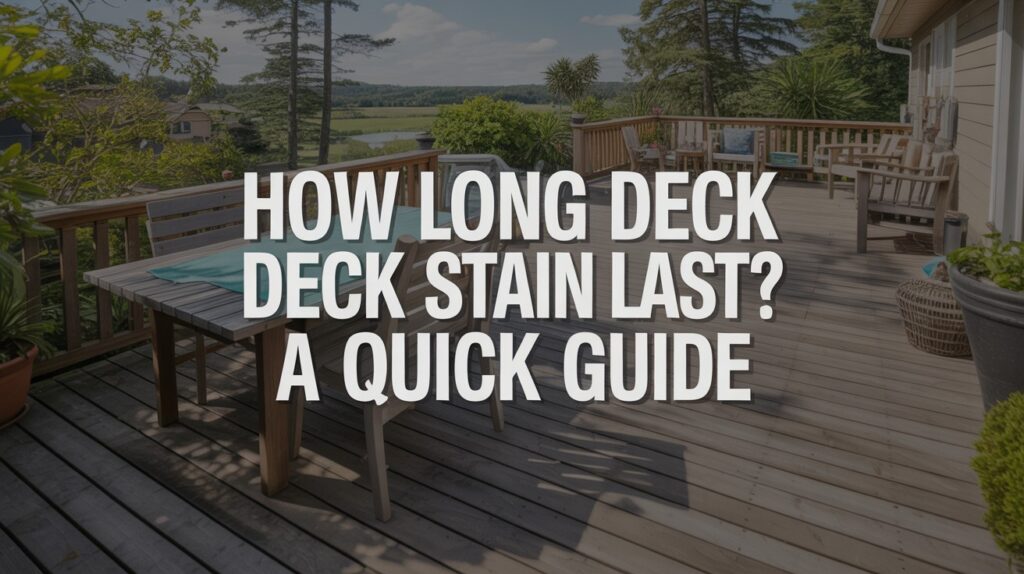Your deck represents a significant investment in your home’s outdoor living space, but maintaining its beauty and structural integrity depends largely on proper staining maintenance.
Many homeowners struggle with timing their deck care, often waiting too long between applications or applying stain too frequently based on manufacturer recommendations rather than actual conditions.
Understanding how long deck stain actually lasts helps you protect your investment while avoiding unnecessary work and expense.
The answer isn’t straightforward-stain longevity depends on multiple factors including product quality, application methods, environmental exposure, and ongoing maintenance practices.
This guide breaks down realistic timeframes for different stain types, identifies key factors that affect durability, and provides practical methods for determining when your deck needs attention.
With proper knowledge and timing, you can maximize protection while minimizing maintenance efforts.
Why Knowing Your Deck Stain Lifespan Matters

Understanding when your deck stain will need renewal isn’t just about aesthetics-it’s about protecting your investment and saving money in the long run. Here’s why staying on top of your deck’s maintenance schedule is crucial:
Prevent Costly Damage from Neglect When stain protection fails, moisture penetrates the wood, leading to rot, warping, and structural issues.
These problems cost significantly more to repair than regular maintenance. A simple restaining every few years can save you thousands in deck replacement costs.
Preserve Curb Appeal and Wood Integrity A well-maintained deck adds value to your property and creates an inviting outdoor space.
Fresh stain keeps wood looking rich and natural while preventing the gray, weathered appearance that comes with exposure to sun and rain.
This consistent care maintains both the beauty and structural soundness of your deck.
Strategic Timing Reduces Work and Repairs Restaining at the right intervals means working with wood that’s still in good condition.
This translates to minimal surface preparation, better stain absorption, and fewer repairs needed before application.
Wait too long, and you’ll face extensive sanding, board replacement, and additional preparation steps that could have been avoided with timely maintenance.
How Long Does Deck Stain Last on Average?
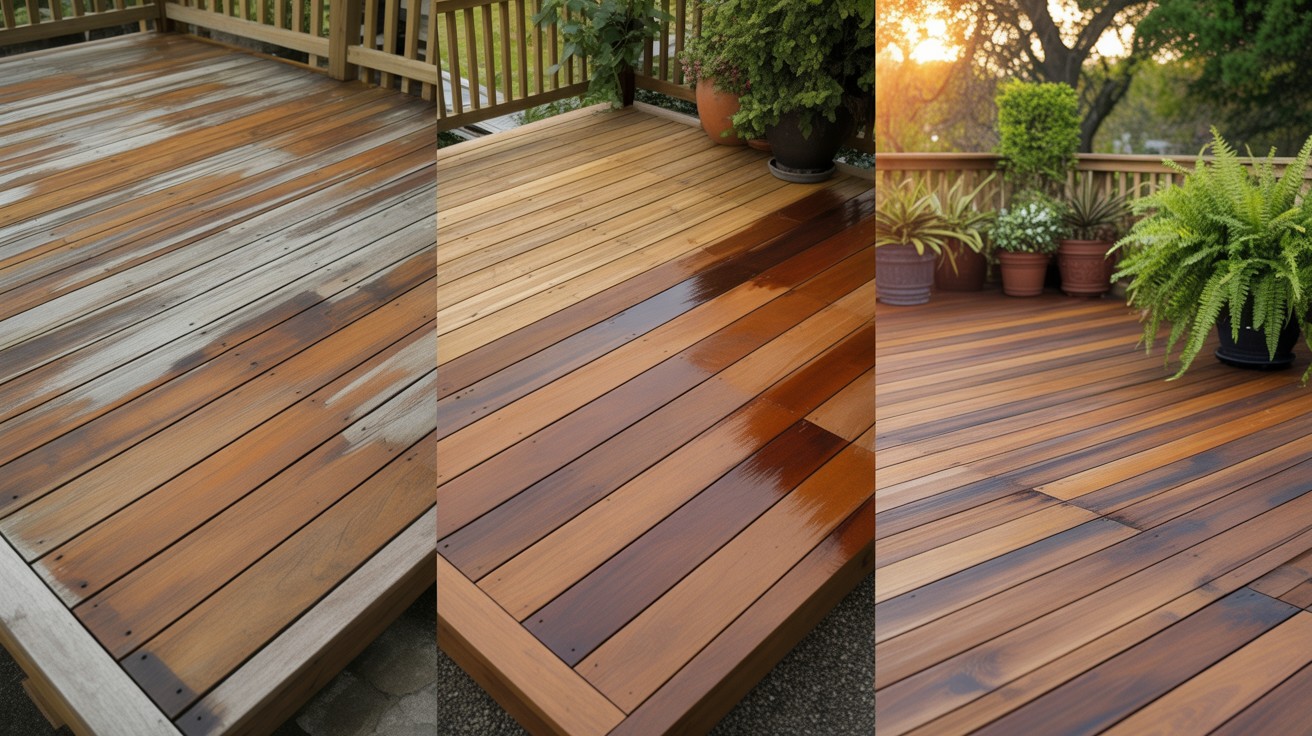
The lifespan of deck stain varies considerably based on the type you choose and environmental conditions. Understanding these timeframes helps you plan maintenance schedules and budget accordingly.
General Lifespan Estimates
Different stain types offer varying levels of protection and longevity.
Transparent and semi-transparent stains typically last 1-3 years, as these lighter stains penetrate deep into the wood but provide minimal surface protection.
While they show off the wood’s natural grain beautifully, they require more frequent reapplication. In harsh climates with intense sun or heavy rainfall, you might need to restain annually.
Solid stains offer better durability, lasting 3-5 years on average. These stains create a protective film on the wood surface, offering superior defense against weathering.
They hide imperfections and provide consistent color coverage, making them ideal for older decks or those with mixed wood types. Their thicker coverage means longer-lasting protection compared to transparent options.
High-quality stains applied with proper preparation can last up to 5 years. Premium products applied to thoroughly cleaned and prepped surfaces can extend protection significantly.
These stains often contain advanced UV blockers, mildew inhibitors, and enhanced penetrating oils that create lasting bonds with the wood.
Manufacturer vs. Real-World Expectations
Manufacturers often suggest yearly applications to ensure warranty coverage and optimal protection.
This conservative recommendation accounts for worst-case scenarios and varying application conditions.
Following these guidelines protects both your deck and any product warranties, though many homeowners find they can extend these intervals in favorable conditions.
Experienced contractors report significant variations based on location.
Decks in moderate climates with covered areas often exceed manufacturer estimates, while those in extreme sun, snow, or coastal salt exposure may need attention sooner than expected.
Professional observations consistently show that proper surface preparation and quality products extend stain life well beyond basic estimates, making the investment in quality materials worthwhile for long-term maintenance savings.
Factors That Affect Deck Stain Longevity
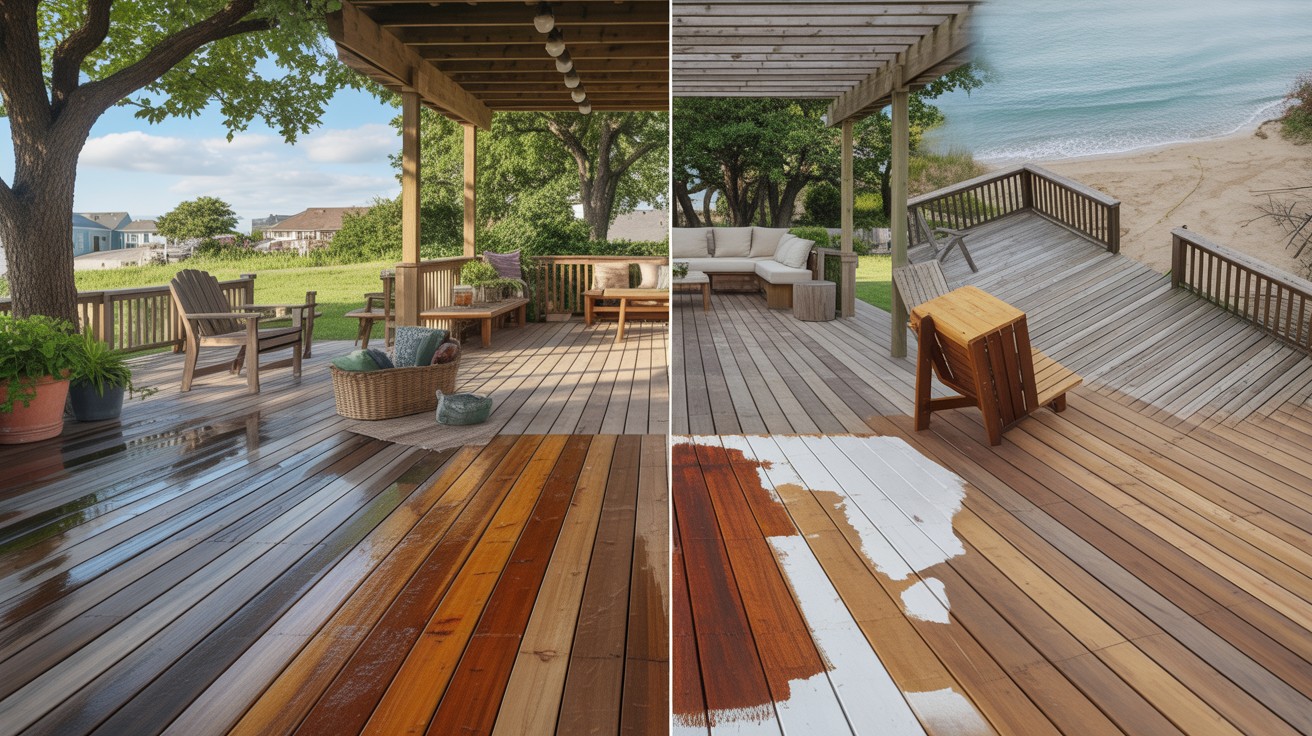
Several key factors determine how long your deck stain will maintain its protective qualities and appearance. Understanding these variables helps you make informed decisions about products, application timing, and maintenance schedules.
Exposure to the Elements
Weather conditions play the most significant role in stain degradation.
Full sun exposure accelerates stain breakdown through UV radiation, causing colors to fade and protective properties to diminish more quickly.
South-facing decks typically show wear faster than those facing north or east. Additionally, rain, snow, and humidity constantly test your stain’s water-resistant properties.
Frequent moisture exposure breaks down the protective barrier, allowing water to penetrate the wood and compromise the stain’s effectiveness.
Deck Location and Environment
Your deck’s specific location creates unique challenges that affect stain longevity.
Coastal areas present particularly harsh conditions, as salt air and sand particles act as abrasives that wear down protective coatings more rapidly.
The combination of salt corrosion and constant moisture accelerates stain failure compared to inland locations.
Conversely, shaded or covered decks benefit from reduced UV exposure and protection from direct precipitation, often extending stain life well beyond average expectations.
Quality of Products Used
The stain you choose significantly impacts longevity and performance.
Budget-friendly stains typically contain fewer protective additives and lower-quality resins, resulting in faster wear and more frequent reapplication needs.
Premium oil-based or hybrid stains incorporate advanced UV blockers, enhanced penetrating oils, and superior binding agents that create longer-lasting protection.
While these products require a higher initial investment, they often provide better value through extended coverage periods and superior wood protection.
Application Technique and Preparation
Proper application methods dramatically influence stain performance and lifespan.
The number of coats applied makes a substantial difference, with single-coat applications offering minimal protection compared to properly built-up coverage with multiple thin coats.
Three coats typically provide optimal protection and longevity. Equally important is surface preparation before application.
Poor preparation, such as applying stain to dirty or damp wood, creates adhesion problems that significantly shorten the stain’s effective lifespan and can lead to premature peeling or uneven wear patterns.
Deck Stain Lifespan by Stain Type
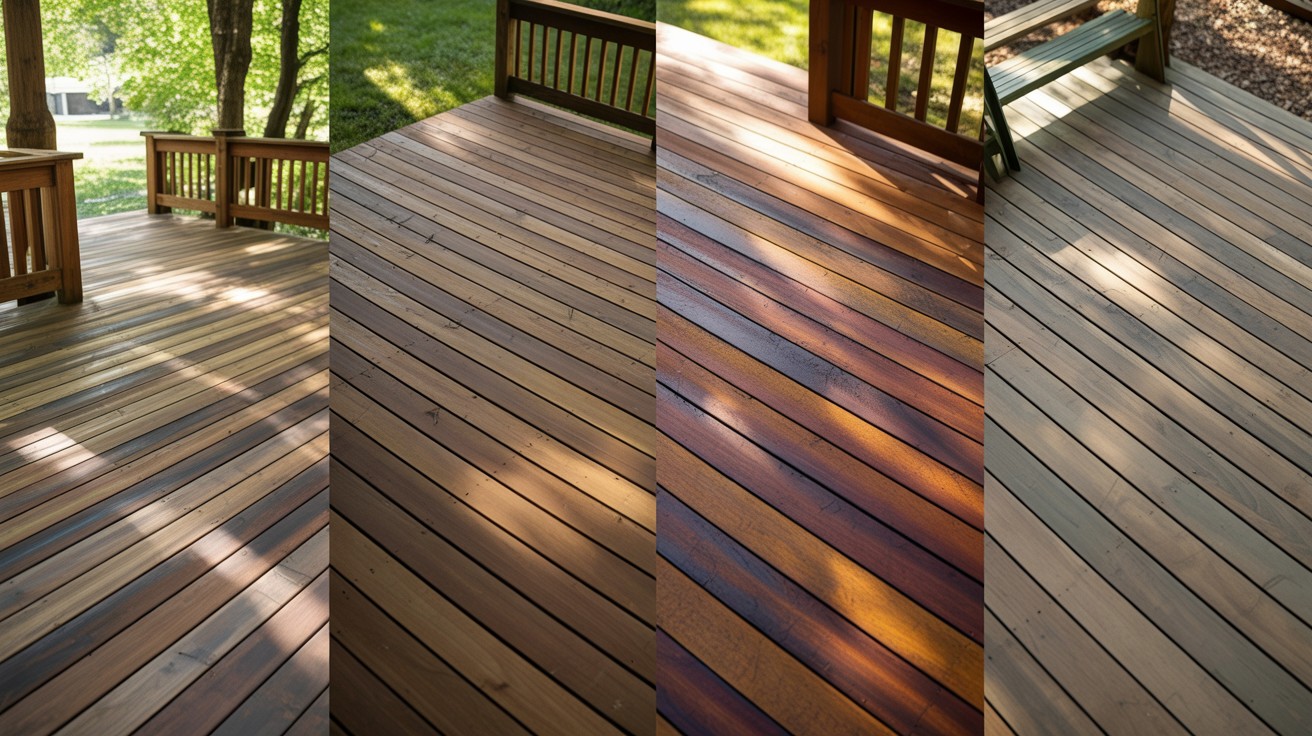
Different stain formulations offer varying levels of protection and durability. Choosing the right type depends on your aesthetic preferences, maintenance commitment, and local climate conditions.
Transparent and Semi-Transparent Stains
These stains provide minimal color while allowing the wood’s natural grain and character to show through clearly.
However, their lighter pigmentation means they offer less UV protection and weather resistance.
The reduced protective barrier results in faster breakdown under sun exposure and moisture infiltration.
Most transparent and semi-transparent stains require renewal every 1-2 years, making them higher-maintenance options that demand regular attention to prevent wood damage.
Semi-Solid and Solid Stains
Stains with higher pigment content create more substantial protective barriers on wood surfaces.
The increased pigmentation provides superior UV blocking and weather resistance, translating to extended protection periods.
Semi-solid stains offer a middle ground between natural wood appearance and protective coverage, while solid stains provide maximum protection with complete color coverage.
These formulations typically maintain their protective qualities for 3-5 years, making them more practical choices for homeowners seeking lower maintenance requirements.
Oil-Based vs. Water-Based Formulations
Oil-based stains penetrate deeper into wood fibers, creating stronger bonds and more durable protection.
This deep penetration results in longer-lasting coverage that weathers more gracefully over time.
The oil base also provides natural moisture resistance and flexibility that moves with the wood as it expands and contracts through seasonal changes.
Water-based stains offer faster drying times and easier cleanup, making them convenient for quick projects.
However, they typically form more of a surface film rather than penetrating deeply into the wood.
This surface coating can be more prone to peeling or flaking as it ages, potentially requiring more frequent maintenance.
While water-based products have improved significantly in recent years, oil-based formulations generally provide superior longevity and weather resistance for deck applications.
How to Tell If Your Deck Stain Is Wearing Out
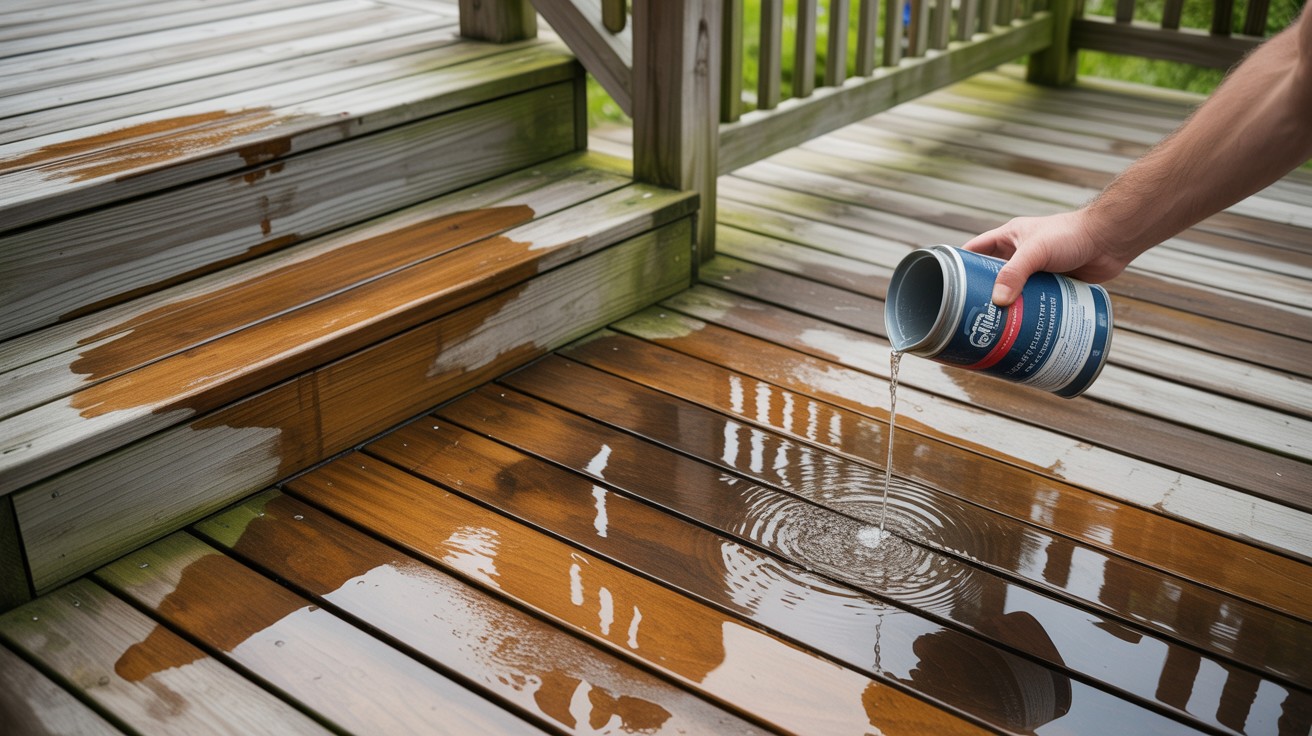
Recognizing the early signs of stain failure helps you address maintenance needs before costly wood damage occurs. Regular inspection and simple testing can save you significant repair expenses down the road.
The Visual Inspection Test
Start by examining your deck’s overall appearance during different lighting conditions.
Look for areas where the original color has faded or become uneven, creating blotchy spots that indicate inconsistent protection.
Pay special attention to high-traffic areas, steps, and railings where wear typically appears first.
Discoloration often begins as subtle changes but progresses to obvious gray or weathered patches where the stain has completely worn away.
South-facing sections and areas with full sun exposure usually show these signs earliest.
The Water Absorption Test
This simple test provides immediate feedback about your stain’s protective capabilities.
Take a small amount of water and splash it onto various sections of your deck, focusing on different areas that receive varying amounts of sun and foot traffic.
Watch how the water behaves on the surface. If the water soaks into the wood quickly, this indicates that the stain’s water-repelling properties have failed and moisture can now penetrate the wood fibers.
When the stain is still functioning properly, water will bead up and roll off the surface rather than absorbing immediately.
Test multiple locations across your deck, as stain failure often occurs unevenly.
Areas under furniture or in shaded spots may still repel water while sun-exposed sections have lost their protection.
This testing approach helps you identify which areas need immediate attention and whether a full deck restaining is necessary or if spot treatment might suffice for the current season.
How to Make Your Deck Stain Last Longer
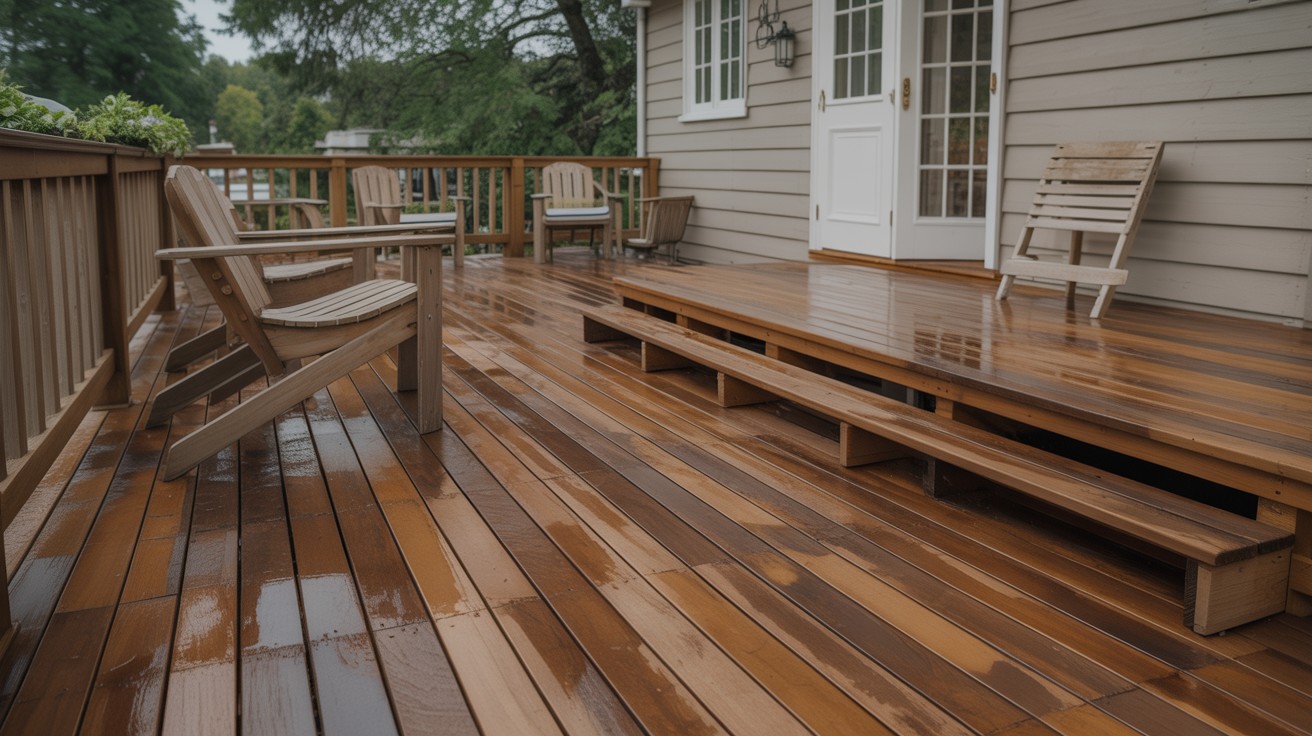
Maximizing your deck stain’s lifespan requires attention to three critical phases: preparation, application, and ongoing care. Following these practices can significantly extend protection and reduce long-term maintenance costs.
Preparation Is Key
Thorough preparation creates the foundation for long-lasting stain performance.
Begin by cleaning your deck completely to remove dirt, mildew, and old stain residue that can interfere with adhesion.
After cleaning, apply a deck brightener to restore the wood’s natural pH balance and open the pores for better stain penetration.
Allow the wood to dry completely before proceeding, as moisture trapped beneath stain causes premature failure and adhesion problems.
Address any rough or weathered spots by sanding them smooth, which ensures even stain absorption and prevents these areas from wearing prematurely.
Pay particular attention to railings, steps, and high-traffic areas that experience more wear. Proper preparation takes time but creates the optimal surface for stain bonding.
Apply Properly
Application technique directly impacts stain longevity and performance. Use 2-3 coats for maximum durability, allowing adequate drying time between each application.
Multiple thin coats penetrate better and last longer than single thick applications that may not bond properly with the wood.
Weather conditions during application are crucial for success. Avoid staining in extreme heat, which causes rapid drying and prevents proper penetration.
Cold temperatures slow curing and can affect final adhesion. High humidity interferes with drying and can trap moisture beneath the stain.
Plan your staining project for mild, dry conditions with temperatures between 50-80°F and low humidity levels.
Ongoing Maintenance
Regular maintenance significantly extends stain life and prevents costly repairs.
Sweep and clean your deck regularly to remove debris that can trap moisture and cause premature wear.
Leaves, dirt, and organic matter create conditions that accelerate stain breakdown if left unaddressed.
Conduct visual inspections every 3 months to catch early signs of wear or damage. Look for areas where traffic patterns or weather exposure are causing faster deterioration.
Address minor issues promptly rather than waiting for widespread failure.
Most importantly, plan to recoat before major fading becomes apparent. Applying fresh stain while some protection remains ensures better adhesion and extends overall coverage.
Waiting until complete failure occurs requires more extensive preparation and may allow wood damage that could have been prevented with timely maintenance.
Final Thoughts: Keep Your Deck Looking Its Best
Maintaining your deck’s appearance and protection requires proactive care rather than reactive repairs.
Regular testing and inspection help you catch wear before it becomes costly damage.
The water absorption test and visual checks should become routine parts of your seasonal maintenance.
Investing in quality products and taking time for proper preparation pays dividends in extended stain life and reduced maintenance frequency.
While budget options may seem appealing initially, premium stains with thorough surface prep consistently outperform cheaper alternatives.
Most importantly, base your restaining schedule on actual conditions rather than arbitrary timelines.
Some decks may need attention after two years, while others remain protected for four or five. Let your deck’s performance guide your maintenance decisions for optimal results.
Frequently Asked Questions
How often should I restain my deck?
Most decks need restaining every 2-4 years, depending on stain type and weather exposure. Transparent stains require more frequent application, while solid stains last longer with proper care.
What makes deck stain fail faster?
Direct sunlight, heavy rain, and high foot traffic accelerate stain breakdown. Coastal environments with salt air and poor initial preparation also reduce stain lifespan significantly.
Can I apply new stain over old stain?
Yes, if the existing stain is still adhering well and not peeling. Clean the surface thoroughly and lightly sand any rough spots before applying the new coat.
How do I know when my deck needs restaining?
Perform the water test by sprinkling water on the surface. If water soaks in quickly instead of beading up, your stain protection has failed and needs renewal.
Does the type of wood affect how long stain lasts?
Absolutely – dense hardwoods like teak hold stain longer than soft woods like pine. Cedar and redwood have natural oils that can interfere with stain adhesion if not properly prepared.

